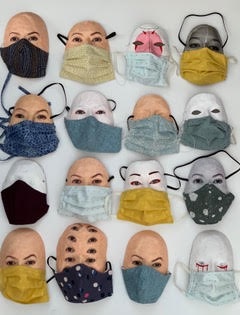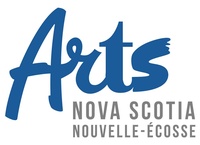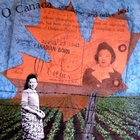If you were to design a mask for yourself for these times, what might it look like?
My favourite recent mask that has come out of the pandemic is a “Woven” mask. I cut up two self-portrait masks and wove the pieces together. Because they don’t fit exactly together, there are pieces of extra eyes and lips which gives a “glitchy” look to it. The interlaced pieces can be seen in terms of mixed race identity or different aspects of our persona woven together. The best part about this mask is that it falls apart when I wear it which I found timely for our situation. It’s representative of me trying to hold this facade together but really, it all comes crashing down when I get overwhelmed and I’m left exposed and open and unprotected. My favourite video work that came from this piece (there’s a couple of variations) is playing the video backwards so that it looks like the mask is building itself over my face.

My goal is to actually make a new mask every week as part of a Creation Grant that I just received from Arts Nova Scotia (yay!) I’m always making new selfportrait masks which are capturing glimpses of our situation right now or some sort of exploration about identity through layers or imagery.
Have you researched masks in Japanese culture?
Yes, my first interest in masks come from Noh Theatre. I haven’t seen them used in performance yet but one day I’ll go to Japan to see in real life. I’ve seen photos and displays in museums and I love the variety of characters and am blown away by the craftsmanship of the masks. I am really inspired by the range of emotions captured in a mask; how depending on the angle and lighting of the mask, the actors can convey so much. My first attempt at integrating Japanese masks with my own self-portrait was of a Noh mask followed by a Kabuki face painted mask. I look to Japanese dolls as well such as Kokeshi and Daruma, as well as other characters from pop culture and folklore. I’ve also been inspired by Bunraku puppetry and have attempted to make a transformational (2-faced) mask sculpture. I’m really interested in researching yokai right now and trying to figure out ways to blend my image with different ghosts or demons.

What about the value of masks as a tool for personal reflections and discovery?
Masks can be so much more than a covering for disguise or protection. It is astounding that even though masks are concealing the face, so much about our inner world can be revealed in that process. I think people could and should use masks as a tool for discovering much about their inner self and psyche. By simply placing a different face over ours and exploring how that feels when looking in the mirror, can open up our minds and help us to see things that were previously hidden and invisible. Realizing how many emotional masks or different personas we wear in different situations, is helpful for self-awareness.
We place so much emphasis in our society on how we look, even though this is fleeting. Through mask making, I am able to alter, distort, and change my appearance. I can slant my eyes as much as I want, to look more or less “Japanese” to see what I would look like. I create multiple variations to show we aren’t just one thing or another. I’m trying to explore that “in-between” space of being mixed race, but I also play with distorting my image to blur the line between beauty and the grotesque. I also love exploring the dynamic space between the inside and the outside and how sometimes they don’t always line up. I make masks where I intentionally mis-align the surface and the structure of the mask or I reveal hidden faces that attempt to show we have an inner (private) self as well as outer (public) personas. Often, how we feel inside doesn’t match up with what we show the world. We build up facades to protect ourselves and sometimes it can take a lifetime to peel back the layers that we’ve built up.
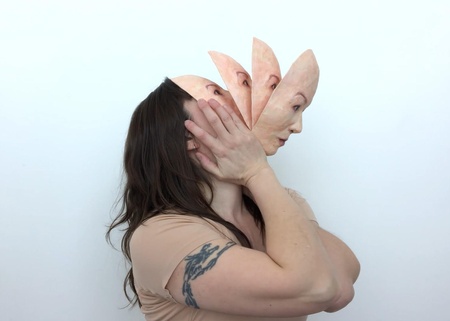
Culturally speaking, how do you define yourself? As an east coaster now, what is your experience with race there? How did you land there?
I’ve always identified as “half-Japanese” but lately I’ve been adopting “Hapa” into my vocabulary and am lately thinking of myself as Nikkei and Yonsei (4th generation Japanese Canadian). Because I’m mixed, it took me a long time to realize that I could call myself Japanese Canadian as well, but it really is such a strong part of my identity. I’ve also realized that it doesn’t have to be one thing or another, there’s a duality that can exist within me and there are many layers and my identity will likely change and shift over time. After my pregnancy and getting older, my face and eyes have changed and I don’t look as Japanese as I did before, and I feel the loss of that. I used to get asked almost daily “Where are you from?” contrasted to now if I mention I’m half-Japanese, people are often surprised.
I ended up in Halifax after living in Montreal for a couple of years after University. A weird twist of fate meant losing my job and ending a relationship at the same time, so I came to visit a few friends from University and I absolutely fell in love with the East Coast. My aunt and uncle happened to visit at the same time and took me on a tour of Nova Scotia. By the end of the trip I knew I wanted to stay here and have since planted roots.
Since moving to Halifax 20 years ago, I finally found a Japanese community here who are wonderful and very welcoming. Most of them have moved here directly here from Japan and often have mixed kids too. Everyone here speaks Japanese fluently and I am often left out of conversation but I don’t mind at all. I love hearing it and I know for them, connecting with each other through their language is so important. Plus, I’m always so happy when I can understand a word or two! I’ve been taking Calligraphy lessons from a wonderful woman, Miyuki Embree, and I ask her and others from the community questions about Japan for references in my artwork all the time.
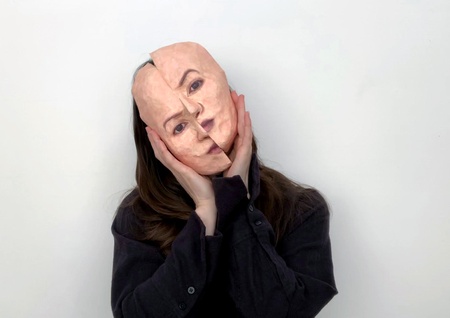
Moving forward, where do you hope your art takes you? Can you talk about how you are getting through these Covid times? How are your parents doing?
I am really excited about the momentum that seems to surround my practice right now. There was a 10 year hiatus away from my studio while raising my daughter full-time. I was invited to exhibit at the JCCC gallery a couple of years ago, so I very happily got back into the studio to make new masks for that exhibit and I haven’t stopped since. I’ve been working hard at putting out grant applications and exhibit proposals and have had some success which is very validating. Looking forward to 2021—I’ll be a part of a group exhibit at Acadia University Art Gallery in February and I’ll have a piece in a Portrait Exhibit in Poughkeepsie, New York in March. I’m currently making new work for an exhibit at Gallery 101 in Ottawa this upcoming May. I’m really grateful to have something to work towards right now as a way of moving my art practise forward but also as a way to cope with the stress of the pandemic. Keeping busy is a very good thing!
I have a rollercoaster of emotions daily during these Covid times. At one point, I’ll be so thrilled because of another art opportunity, that for “some reason” working in the medium of masks right now is extremely relevant and timely! But then the next minute I’ll be reading about an anti-mask rally or the growing numbers of cases and feel overwhelmed. I miss my family so much and I don’t like being so far away from them.
My family and I have been preparing all fall, to get into the mindset of a pretty difficult lonely winter and spring ahead of us. Once more and more vaccines become available and the weather gets warmer again, we’ll hopefully have a much brighter outlook on life. We just have to all get through this winter and stay safe so we can all be together again in the future. And hope that people can start working together instead of being so divided, and smartening up too, in order to keep more people safe.
My parents are hanging in there. We all worry about my mom since she has COPD and could be affected quite severely if infected. She doesn’t make pottery anymore due to arthritis in her hands. In the summer, she loves to garden but the winter months are pretty hard to begin with. Thank goodness for FaceTime and Zoom calls though. Like everyone else, that’s been our lifeline.
Can you introduce us to your east coast family?
My husband Jake has lived in Halifax his whole life. We met over 15 years ago through a friend who worked with him in theatre production. Jake was intrigued by a painting I did for an auction fundraiser for the company. So it was through my artwork that we connected, which I love! We got married in 2007 and we have a daughter Azalea who is now 12. She is also so artistic and loves to draw. She is currently obsessed with the book series Wings of Fire and she draws dragons non-stop. She’s used to seeing weird masks and faces all around the house and often has great ideas to contribute. Jake builds bass guitars, is super creative and loves taking photographs of nature—especially the birds in our backyard. He’s a “Maker” too and unfortunately is stuck right now with the ongoing, not-so-fun jobs of fixing up our house. I am blessed to have Ethel in my life—she’s the best mother-in-law ever—and lives here in Halifax so we see her often. Together everyone is so completely supportive of my art making, so I am very grateful to have so much encouragement all around me.
What kind of identity do you want your own kids to embrace?
It’s so interesting how much Azalea has identified with her Japanese side. Because I strongly identify with my Japanese side, it’s definitely been passed on. It also helps that her friend is half-Japanese and she has many friends from Korea who come here for school. It’s always been considered “cool” to be Asian in her class. She also loves learning about her Latvian and Jewish heritage from her father.
I’m honestly happy however she sees herself, and I’m so proud of the person she is and is becoming. She’s been learning to speak Japanese—even continuing online during the pandemic. She’s come with me to Calligraphy lessons and has learned some kanji and is a natural with the brush. Her favourite foods are sashimi, maki, and udon. Whenever there was a Multicultural event at her school, she would wear a Yukata. I’m really happy because it is reclaiming in a way part of what my mother had lost, being born after the war with the surrounding racism. I see it as generational healing as she embraces her culture and as I learn about and incorporate Japanese imagery into my art work. We are healing the wounds of the past and I think that’s really beautiful.
* * * * *
She also has work in a group show in a very unique gallery in the UK - a dollhouse that functions as a gallery called The House of Smalls. This exhibit called The Portrait Within runs from Feb. 20 - March 20, 2021.
The group exhibit at Acadia University Art Gallery, Alone, runs from Feb. 10 - April 13th, 2021.
Miya would like to acknowledge the support from Arts Nova Scotia for helping her artwork flourish.
To see more of Miya’s work, please check out her instagram page @miyamask and her website.
© 2021 Norm Ibuki


